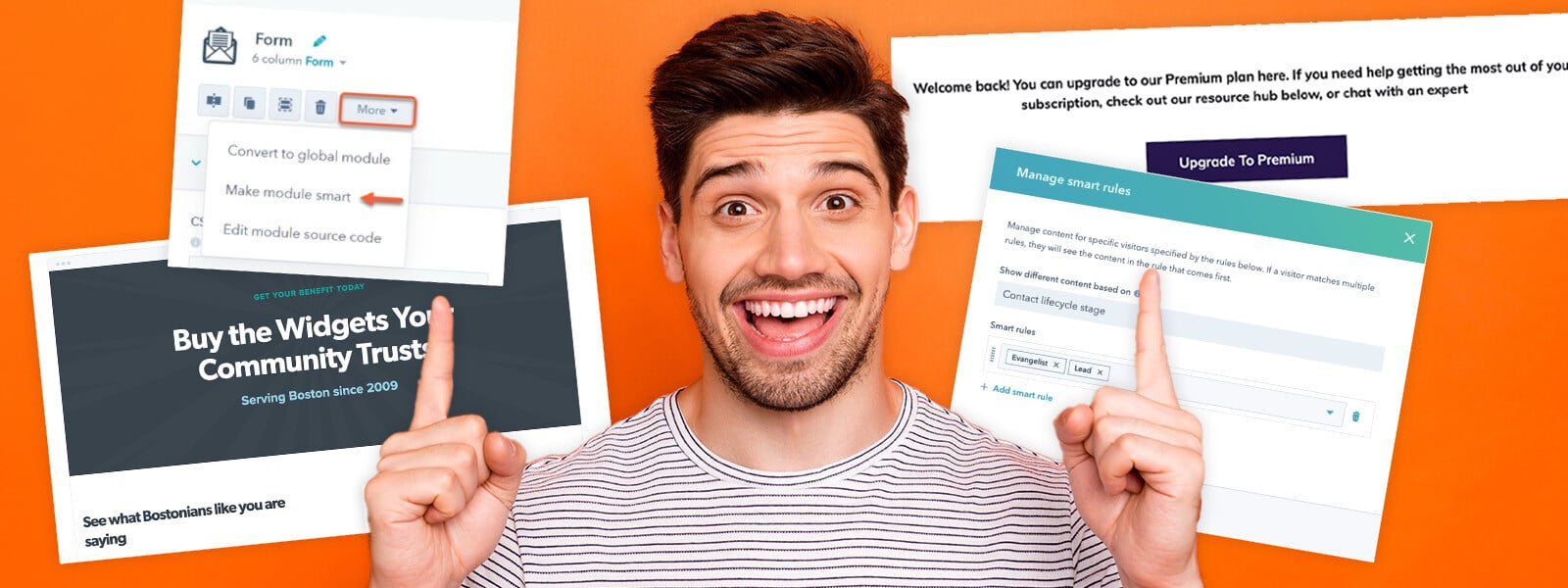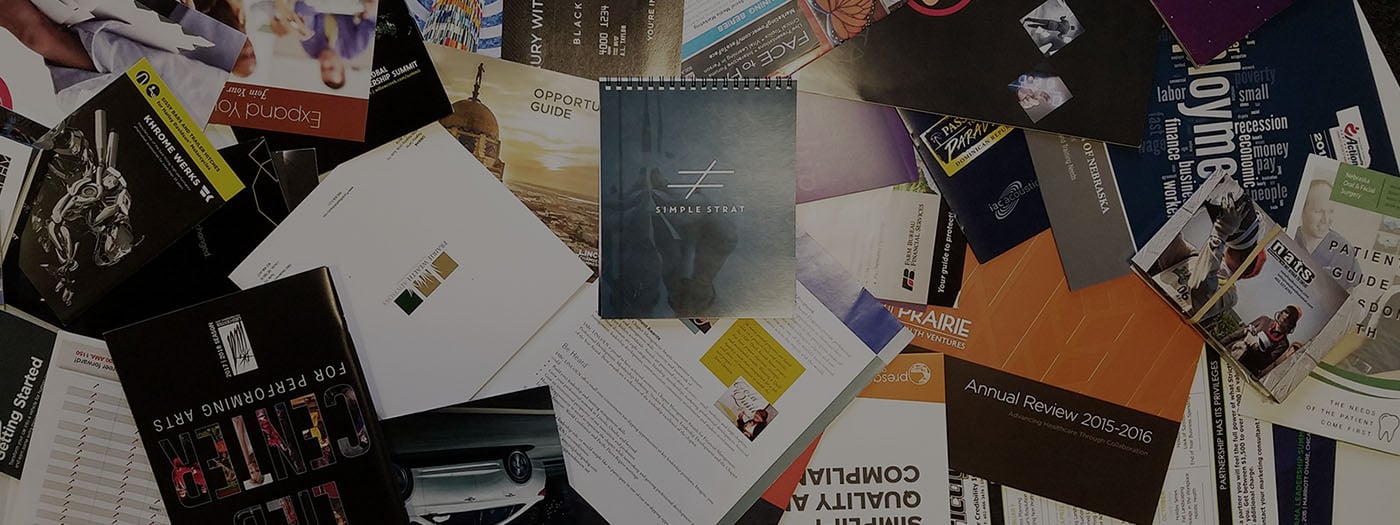Using HubSpot Smart Content: 8 Ideas You’ll Want to Steal
January 16, 2025

Ali Schwanke

Imagine a custom website that morphs for each visitor—tailored to their interests, priorities, and even past behavior. It’s not sci-fi. It’s HubSpot Smart Content, turning your site into a personal concierge. Thanks to today’s “order-everything-on-Amazon” mindset, people don’t just enjoy personalized experiences—they expect them.
Smart Content delivers that “built-just-for-me” feel. It’s the secret sauce that drives engagement, boosts conversions, and stops your site from feeling like a cookie-cutter template. Best of all, it’s simpler to implement than you might think.
So how do you actually make it happen? We’ve pulled together the “CliffsNotes” version. Here are eight clever ways to use Smart Content, along with a stack of ideas to help you build a truly personal experience for every visitor.
1. Smarter calls-to-action (CTAs)

CTAs are where visitors take action, so making them feel personal can make all the difference — the more your copy is personalized to the visitor, the more effective it becomes. With Smart Content, you can create CTAs that adapt to who’s on your site and what they’re looking for.
- For new visitors: Introduce yourself with a “Learn More” or “Explore Our Services” button.
- For leads: Push them closer to buying with “Request a Demo” or “Download Our Guide.”
- For current customers: Try something like “Upgrade Your Plan” or “Leave a Review.”
Example: Think of a gym website. New visitors see a free trial offer, while members get a link to book a class or upgrade to personal training.
2. Adapt your content to fit every screen
People expect websites to work seamlessly whether they’re on their phone, tablet, or computer. Smart Content ensures your site delivers the right experience for each device, increasing engagement and reducing frustration.
How to optimize Smart Content for devices:
- Simplify for mobile: Mobile visitors benefit from short forms, tap-friendly buttons, and minimal text.
- Expand for desktops: Desktop users can handle more detail, like long-form content or complex navigation.
Pro tip: Mobile traffic isn’t slowing down. Test your Smart Content on phones and tablets to catch anything that’s not working.
3. Adjust your content based on location

Where someone is browsing from can shape what they care about. Smart Content lets you customize offers, language, and features to match their location, creating a more relevant experience.
- Offer local promotions (e.g., “Free shipping to Chicago!”).
- Adjust language based on their region.
- Highlight location-specific case studies or events.
Examples: A SaaS company might show U.S. customers pricing in dollars but display euros for visitors in Europe. Or an ecommerce site might only display “Free shipping” to visitors from applicable countries.
4. Personalize your landing pages to be consistent with your ads
When someone clicks on an ad, they’ve already shown interest in what you’re offering. The last thing you want is to drop them on a generic page that doesn’t connect with their expectations. Smart Content helps align your landing page with the ad, creating a seamless and relevant experience.
How to use Smart Content for ad personalization:
- Match the offer to the ad: If your ad promises “20% off your first order,” your landing page should prominently feature that discount, not bury it in fine print.
- Use consistent visuals: If your ad includes a specific product image or branding, carry those visuals over to the landing page. Familiarity builds trust.
- Tailor the page message to the ad source: Visitors from a LinkedIn ad might respond better to professional or B2B-focused language, while Facebook ad clicks might benefit from a more casual tone.
For instance, if you’re promoting a webinar with an ad like “Join our free webinar: 5 Ways to Streamline Your Sales Process,” the landing page should feature the webinar details, an easy registration form, and a downloadable resource related to the topic.
5. Tailor your content for every buyer stage

Not everyone comes to your site ready to buy. Smart Content shows visitors exactly what they need based on where they are in the buyer journey. New visitors might see an intro guide or blog post, leads get a demo offer or pricing details, and customers see advanced features or loyalty rewards. It’s an easy way to keep your content relevant and keep visitors moving toward their goals.
- For prospect or ”browsers”: Educational resources like blogs, guides, or videos.
- For shoppers: Product comparisons, demos, or pricing info.
- For customers: Highlight loyalty programs or upsell features they don’t already use.
Example: If someone’s downloaded a pricing guide, show them a demo offer next time they visit.
6. Speak their language (industry messaging)
Not all industries are the same, and your visitors want to feel like you understand their unique challenges. Smart Content lets you create messages tailored to each industry or persona.
- Show industry-specific case studies (e.g., a testimonial from a healthcare company for healthcare visitors).
- Talk about how your product solves pain points common in their field.
- Highlight features that matter most to their industry.
Pro tip: Use HubSpot’s segmentation tools to tag contacts by industry. Then create Smart Content just for them.
7. Use dynamic forms that work smarter, not harder
Filling out forms isn’t fun, but Smart Content can make it easier for visitors—and more useful for you. Dynamic forms adapt based on who’s filling them out, so you can gather just the right amount of information.
- Pre-fill fields for known visitors to save them time.
- Use progressive profiling to ask for new info each time they visit.
Example: If someone’s already shared their name and email, the next form might ask for their company size or job title.
Pro tip: With HubSpot's Breeze AI tools, you also have "form shortening," which removes any fields for info you already have

Learn more about using HubSpot forms effectively.
8. Recognize returning visitors
When someone comes back to your website, they expect you to know who they are — not in a creepy way, but in a way that makes their site experience more personal. Smart Content helps you create an experience that feels personal by recognizing their past interactions and tailoring what they see.
- Show personalized product recommendations or content based on their browsing history.
- Offer returning customers exclusive discounts or early access to new products.
Example: A SaaS platform might recognize a returning trial user and display a personalized message like “You’re halfway through your trial—here’s how to get the most out of it,” with a CTA to schedule a call with a customer success manager.
Your Smart Content checklist

Smart Content in action: before and after examples
Without Smart Content |
With Smart Content |
|
Everyone sees a generic “Contact Us” button. |
New visitors see “Learn More,” leads see “Request a Demo,” and customers see “Upgrade Your Plan.” |
|
Leads get the same CTA as everyone else. |
Leads see “Download Our Guide” or “Start Your Free Trial.” |
|
Existing customers see CTAs for services they already use. |
Customers see relevant CTAs like “Explore Advanced Features” or “Refer a Friend.” |
|
Mobile visitors see desktop-optimized forms with 10 fields. |
Mobile visitors see shorter, tap-friendly forms with just 3 fields. |
|
Desktop users see the same simplified content as mobile users, which feels incomplete. |
Desktop users see more detailed content like case studies or downloadable whitepapers. |
|
Everyone sees “Free Shipping,” even if it doesn’t apply to their area. |
Visitors in California see “Free Shipping to California,” while others see region-specific offers. |
|
The site highlights case studies irrelevant to the visitor’s location or industry. |
Visitors see localized case studies or examples tied to their region or sector. |
|
Landing page doesn’t reflect the ad’s promise, causing confusion. |
Landing page matches the ad’s value proposition (e.g., “20% off your first order” prominently displayed). |
|
Visuals and language are generic, creating a disjointed experience. |
Visuals and messaging align with the ad, building trust and continuity. |
|
A visitor from LinkedIn sees the same content as someone from Facebook. |
LinkedIn visitors see B2B-focused language; Facebook visitors see casual, consumer-oriented messaging. |
|
Everyone sees the same homepage focused on selling the product. |
Prospects see educational resources like blogs and guides; leads see demos or comparisons. |
|
Leads have to dig through unrelated content to find decision-stage material. |
Leads see decision-stage content like pricing information or feature comparisons. |
|
Existing customers see introductory CTAs and beginner-level content. |
Customers see upsell opportunities, loyalty programs, or advanced product features. |
|
Everyone sees generic testimonials that might not resonate with their industry. |
Visitors see testimonials or case studies relevant to their specific industry. |
|
The site promotes all features equally, even those irrelevant to certain industries. |
Visitors see features tailored to their sector (e.g., compliance tracking for legal teams). |
|
A returning visitor has to re-enter their email and company name on every visit. |
Returning visitors see pre-filled forms with their existing information. |
|
First-time visitors are hit with a 10-field form that feels overwhelming. |
Progressive profiling asks only a few questions at a time, building their profile over multiple visits. |
|
A returning visitor sees a generic homepage, unrelated to their past behavior. |
The homepage highlights products or content they’ve viewed or similar recommendations. |
|
All visitors see the same promotional banner, regardless of their engagement. |
Returning visitors see offers like “Welcome back! Here’s 10% off your next order.” |
|
A returning lead gets the same beginner-level blog list as new visitors. |
Returning leads see advanced resources like webinars or in-depth guides based on their stage in the funnel. |
Getting started
Even the best Smart Content needs tweaking to perform at its best. Use HubSpot’s built-in tools to monitor how your content is doing.
- Track engagement and conversions to see what works.
- A/B test different versions of Smart Content to learn what your audience responds to.
Whether it’s tailoring CTAs, simplifying forms, or personalizing for different devices, there’s a lot you can do to make your site more engaging and effective. Start small—try one idea, see how it works, and build from there. Learn how to create and manage smart content rules
Ready to see what Smart Content can do for you? Let’s talk about making it happen.

Ali Schwanke
Ali Schwanke is the CEO and co-founder of Simple Strat, a HubSpot Solutions Partner. She’s a top contributor for Martech.org, a frequently sought out podcast guest, and host of her own show Marketing Deconstructed, where she shares insights on B2B content strategy and marketing. She’s also the founder and co-host of HubSpot Hacks, and is an advisor for professional education partners like Thinkific and Vistage.
Relevant Blog Posts

Top 26 HubSpot Hacks for Marketing Pros
If you've invested in HubSpot Marketing Hub, you know the promise: powerful growth, streamlined processes, a happy team. But let's be real – there's a TON of info out there on HubSpot. Sorting...

Marketing Collateral: The Ultimate Guide (With Examples)
When we’re talking about marketing, things can get kind of buzz-wordy. Marketing collateral. Landing pages. Audience personas. Ever feel like you need a guide to walk you through these things?...

Using Content for Top-of-Funnel Marketing (Plus Examples)
What does your content have to say? Does it answer your audience’s most burning questions? Does it bring them value after they read, watch, or listen to it? Delivering value via content is especially...

